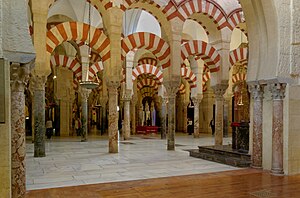Mezquita de Córdoba
The Mezquita (Spanish for "mosque") of Cordoba is a Roman Catholic cathedral. It used to be a mosque in the Andalusian city of Córdoba, Spain. [1] At first the site had been used for a temple, then a Christian cathedral. Under the rule of Islam, it was built as the second-largest mosque in the world. It is perhaps the most accomplished monument of the Umayyad dynasty of Cordoba. It changed into mosque in Middle Ages. [2]After the Spanish Reconquista, it was changed back into a church, and some of the Islamic columns and arcs were replaced by a basilica in early Baroque style. Many early mosques have a square or rectangular plan. They also have a prayer hall and an enclosed courtyard. This is known as Arab-plan. The first mosques of this type were built during the Umayyad Dynasty.


In the warm Mediterranean and Middle Eastern climates, the courtyard served to hold the large number of worshippers during Friday prayers. Often, hypostyle mosques have outer arcades. They allow the visitors to enjoy the shade. Arab-plan mosques were built mostly during the Umayyad and Abbasid dynasties. The Arab plan was very simple, which did not allow for much further development. This caused that style of mosque to fall out of favour.[3] The flat roof of the prayer hall was supported by columns. Many rows of columns were needed to support such roofs;.[4] this is called "hypostyle architecture". Today it houses the main church of the diocese of Cordoba in Spain. One of the most famous hypostyle mosques, it is supported by over 850 columns.[5]
